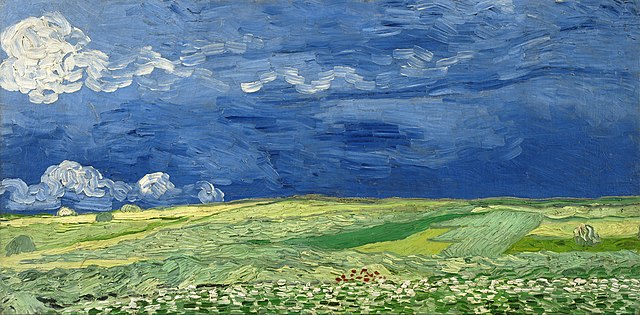
Look closely at the painting Wheatfield Under Thunderclouds by Vincent van Gogh.
The following activities and questions are designed to help your students use their noticing skills to move through the poem and develop their thinking skills so they understand its meaning with confidence, using what they’ve noticed as evidence for their interpretations. Read more about the framework upon which these activities are based.
-
Warm-up: Look closely at the painting Wheatfield Under Thunderclouds by Vincent van Gogh. What stands out to you in this painting? Why? What emotions do the colors evoke? Why? Look again. What else do you see?
-
Before Reading the Poem: (Teachers, before class ask students to bring in a photograph/image of someone or something that is meaningful or helpful to them. They will share these.) Find a partner or small group and share the image you brought with you today. Explain how this person, place, or thing is meaningful to you.
-
Reading the Poem: Silently read the poem “[I wandered lonely as a Cloud]” by William Wordsworth. What do you notice about the poem? Note any words or phrases that stand out to you, or any questions you might have.
-
Listening to the Poem: Enlist two volunteers and listen as the poem is read aloud twice. Write down any additional words and phrases that stand out to you.
-
Small-group Discussion: Share what you noticed about the poem with a small group of students. Based on the details you just shared with your small group and the resources from the beginning of class, what impact do you think that the daffodils have on the speaker? Why? Has anything in nature or the natural world ever impacted you? If so, how and why?
-
Whole-class Discussion: What do you think of the title “[I wandered lonely as a Cloud]”? What might it mean to wander lonely as a cloud? What does this poem have to say about loneliness? Joy?
-
Extension for Grades 7-8: Look back at the image that you brought into class today. What stands out to you most in this image? Why? Look again. What else do you see? Write a poem inspired by this image or Wordsworth’s poem.
-
Extension for Grades 9-12: Read the article “A Brief Guide to Romanticism.” Then, choose one poem to read. Join your classmates in a Socratic seminar to discuss how poets like Wordsworth use the natural world, passion, and a connection to the mystic in poetry. How does writing about the natural world feel today? Can you think of any other artists who also explore similar themes? Share your ideas.
Teach This Poem was developed for in-person classrooms, but it can be easily adapted for remote learning and hybrid learning models. Please see our list of suggestions for how to adapt this lesson for remote or blended learning.
“Manifestos are an unruly lot. In opposition to a reigning ideology, they create vibrancy. But in support of dominant power? They stultify. This is true of William Wordsworth’s preface to Lyrical Ballads. Written when he was just twenty-eight years old, it had a tremendously generative run of at least one hundred and fifty years. But Wordsworth wasn’t shooting merely for a good run; he wanted ‘to interest mankind permanently.’ I don’t know about eternity, but I know that two centuries after it was written, the preface is certainly considered ‘definitive.’ Only, how much does it matter?” Read Tom Thompson’s essay, “The State of the Preface Address: on Wordsworth and Common Speech.”
